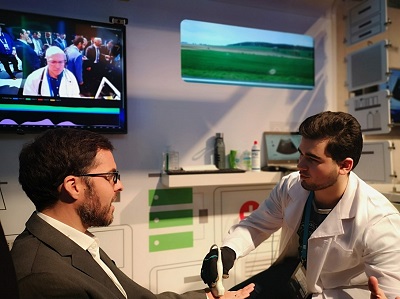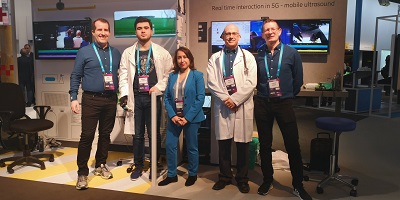Ultrasound through 5G showcased at MWC 2019
Researchers in the Centre for Telecommunications Research, Department of Informatics, presented real-time interaction between a hospital and an ambulance using 5G networks at this year’s Mobile World Congress.
Held earlier in 2019 in Barcelona, the international mobile fair played host to the King’s team led by Dr Toktam Mahmoodi, supported by PhD student Konstantinos Antonakoglou and undergraduate student Eugeniu Dimitriu, and their industry partners BT and Ericsson.

The 5G demonstration in progress at MWC 2019
The 5G demonstration showcased how a medical expert located in a hospital could start early diagnosis of a patient on the move and in an ambulance using audio, video and haptic communications.
With a complete view of the patient in the ambulance, the medical expert can guide the paramedic treating them using haptic interaction with a diagnostic device. The particular case on show at MWC was ultrasound, as ultrasound images need real-time interpretation by an expert.
During the showcase, the paramedic wore a haptic glove and operated an ultrasound device in the ambulance. The medical expert in the hospital was able to see footage from the ambulance and the ultrasound image on separate digital screens, and sent instructions to the haptic glove through a joystick. This directed the paramedic to move the ultrasound sensor accordingly.

Dr Toktam Mahmoodi (centre) and the project team at MWC 2019
There are significant benefits to this work; for example, using haptic interaction between the medical expert and the paramedic, instead of audio communication, greatly reduces the chance of commands being wrongly interpreted.
In addition, the fact that the interaction is between two humans, rather than a human and a robot, means that the technology could be put into practice without the need for a change in medical legislation.
Read more about the Centre for Telecommunications Research